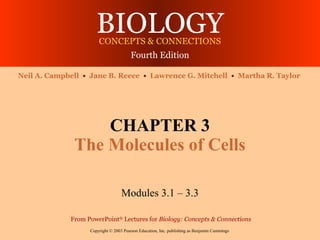
How Molecules Determine Life's Diversity
- 1. BIOLOGYCONCEPTS & CONNECTIONS Fourth Edition Copyright © 2003 Pearson Education, Inc. publishing as Benjamin Cummings Neil A. Campbell • Jane B. Reece • Lawrence G. Mitchell • Martha R. Taylor From PowerPoint® Lectures for Biology: Concepts & Connections CHAPTER 3 The Molecules of Cells Modules 3.1 – 3.3
- 2. Copyright © 2003 Pearson Education, Inc. publishing as Benjamin Cummings • Life’s diversity results from the variety of molecules in cells • A spider’s web-building skill depends on its DNA molecules • DNA also determines the structure of silk proteins – These make a spiderweb strong and resilient Spider Silk: Stronger than Steel
- 3. Copyright © 2003 Pearson Education, Inc. publishing as Benjamin Cummings • The capture strand contains a single coiled silk fiber coated with a sticky fluid • The coiled fiber unwinds to capture prey and then recoils rapidly Coiled fiber of silk protein Coating of capture strand
- 4. Copyright © 2003 Pearson Education, Inc. publishing as Benjamin Cummings • Life’s structural and functional diversity results from a great variety of molecules • A relatively small number of structural patterns underlies life’s molecular diversity INTRODUCTION TO ORGANIC COMPOUNDS AND THEIR POLYMERS
- 5. Copyright © 2003 Pearson Education, Inc. publishing as Benjamin Cummings • A carbon atom forms four covalent bonds – It can join with other carbon atoms to make chains or rings 3.1 Life’s molecular diversity is based on the properties of carbon Figure 3.1, top part Structural formula Ball-and-stick model Space-filling model Methane The 4 single bonds of carbon point to the corners of a tetrahedron.
- 6. Copyright © 2003 Pearson Education, Inc. publishing as Benjamin Cummings • Carbon skeletons vary in many ways Ethane Propane Carbon skeletons vary in length. Butane Isobutane Skeletons may be unbranched or branched. 1-Butene 2-Butene Skeletons may have double bonds, which can vary in location. Cyclohexane Benzene Skeletons may be arranged in rings. Figure 3.1, bottom part
- 7. Copyright © 2003 Pearson Education, Inc. publishing as Benjamin Cummings • Functional groups are the groups of atoms that participate in chemical reactions – Hydroxyl groups are characteristic of alcohols – The carboxyl group acts as an acid 3.2 Functional groups help determine the properties of organic compounds
- 8. Copyright © 2003 Pearson Education, Inc. publishing as Benjamin Cummings Table 3.2
- 9. Copyright © 2003 Pearson Education, Inc. publishing as Benjamin Cummings • Most of the large molecules in living things are macromolecules called polymers – Polymers are long chains of smaller molecular units called monomers – A huge number of different polymers can be made from a small number of monomers 3.3 Cells make a huge number of large molecules from a small set of small molecules
- 10. Copyright © 2003 Pearson Education, Inc. publishing as Benjamin Cummings • Cells link monomers to form polymers by dehydration synthesis 1 2 3 Unlinked monomer Removal of water molecule 1 2 3 4 Longer polymer Figure 3.3A Short polymer
- 11. Copyright © 2003 Pearson Education, Inc. publishing as Benjamin Cummings • Polymers are broken down to monomers by the reverse process, hydrolysis Coating of capture strand 1 2 3 Addition of water molecule 1 2 3 Figure 3.3B 4
